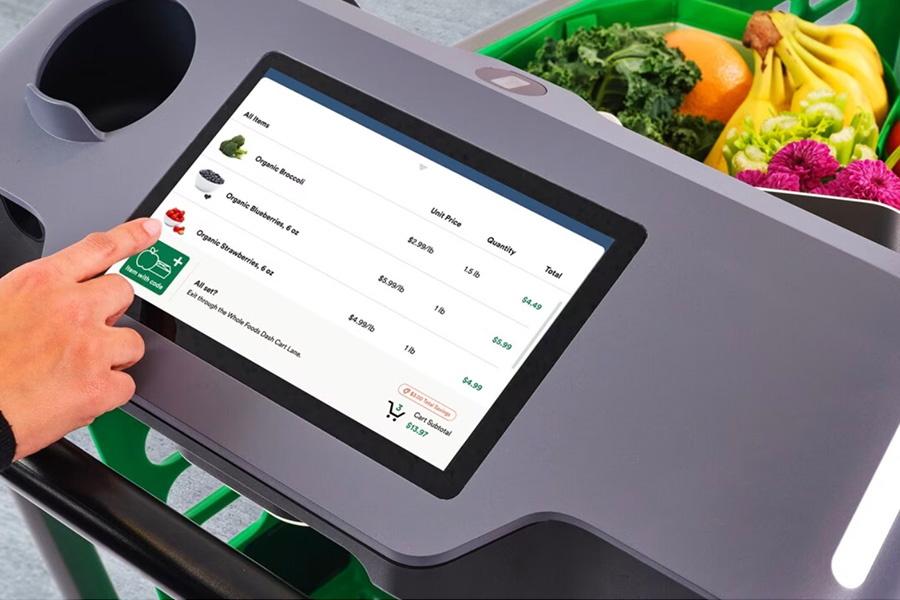The next evolution of the Dash Cart: New features and expansion to first Whole Foods Market Store
In September 2020, Amazon’s physical retail team introduced the Amazon Dash Cart—a smart shopping cart that helps make grocery trips quicker by skipping the checkout line. We’ve since made the Dash Cart available for use at many Amazon Fresh stores across the U.S., listened to shopper feedback on the cart and their ideas for the future, and watched as customers excitedly told us how they love the ease of use, convenience, and time saved by using the Amazon Dash Cart.
Today we’re excited to announce a new version of the Dash Cart—offering new features to make shopping with the Dash Cart even easier and more convenient. We’ve built the updated version of the Dash Cart to continue to offer the features people love most, like real-time receipts and the ability to weigh produce directly in the cart’s basket, alongside new conveniences and behind-the-scenes technology advancements that further improve the Dash Cart shopping experience.

Features of the new version of the Dash Cart include:
- The new carts weigh less than the original version but have more than double the capacity of the previous carts, holding four grocery bags instead of two
- Carts now include a delicates shelf as well as a lower shelf for oversized items
- The new carts are weather resistant so they can go all the way to the car for added convenience
- The Dash Cart screen will now display images of fresh items nearby, like produce, for shoppers to choose from, or shoppers can type in the item name (“tomato,” for example) instead of a four-digit PLU code
- We’ve evolved the carts’ ability to more precisely determine where the cart is in the store to better show nearby products and deals
- The carts feature an extended all-day battery life that requires less charging, making them even more readily available for customers
These updates are the result of customer feedback, improved computer vision and sensor fusion technology, and backend innovation and testing. For example, we doubled the capacity of the cart while maintaining the ability to quickly measure produce weight for certified accuracy and price. Consider stepping onto a scale, which usually takes a few moments to stabilize and produce a final weight. The Dash Cart stabilizes nearly instantly—we’ve created algorithms that can determine signal from noise, like the cart moving through the store (noise), so it can calculate weight (signal) without asking shoppers to stop the cart.
Because we expanded the size of the cart, we knew shoppers would want to take the carts all the way to their cars, which meant the carts would have to be able to withstand summer heat and winter cold. To test durability, we baked the technology in an oven and froze test carts in a giant freezer to ensure they would survive harsh weather conditions. We also dropped heavy weights into test carts’ baskets more than 100,000 times to ensure they would remain usable after impact—needless to say, we feel confident the Dash Cart is durable.
Our goal has always been to provide helpful shopping solutions—like the Dash Cart—to customers where they’ll find them most useful. With that, I’m happy to share that for the first time, the Dash Cart—specifically the new version—will be available for use at the Whole Foods Market store in Westford, Massachusetts in the coming months, followed by a few additional Whole Foods Market stores and many Amazon Fresh stores in the U.S.
“As many of our customers return to their in-store grocery shopping routines, it’s exciting to introduce new and unique ways for them to shop our stores,” said Leandro Balbinot, chief technology officer for Whole Foods Market. “We’re thrilled that the newest version of Dash Cart will debut in our Westford store and can’t wait to hear the feedback from our customers there.”
To use the new version of the Dash Cart, shoppers log in through a QR code in the Amazon or Whole Foods Market app, which allows them to easily sign in and begin using the cart. From there, shoppers place their bags (if using them) in the cart and start shopping, scanning their items using one of the cameras near the handlebar of the Dash Cart. The cart uses a combination of computer vision algorithms and sensor fusion to help verify each item placed in—and removed from—the cart. The Dash Cart’s screen shows a real-time receipt of all items in the cart, and when shoppers are ready to check out, they simply exit the store through the Amazon Dash Cart lane and their payment is processed using the credit card associated with their Amazon account. Shoppers will receive an emailed receipt shortly after leaving the store.
The Dash Cart is one of the ways we’re helping customers save time during grocery shopping trips, and the recent enhancements include the features shoppers said they wanted most, giving them another option to reduce friction from grocery shopping trips of all sizes. Our goal with the Dash Cart has always been to make in-store shopping more convenient by eliminating the need to stand in checkout lines or unload and reload items at self-checkout stations, and we hope shoppers enjoy these updates as much as we think they will.
Source: About Amazon




